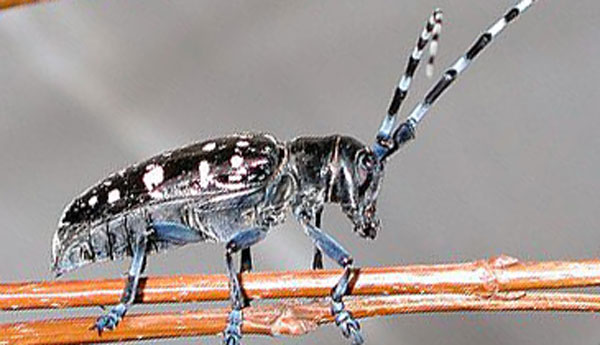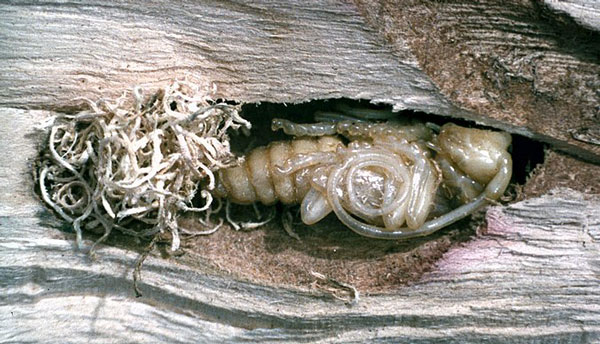
August is a great time to enjoy the outdoors, and it’s also the best time to spot the invasive Asian longhorn beetle as adults emerge from trees. That’s why the U.S. Department of Agriculture is declaring August as “Tree Check Month.” Checking trees for the beetle and the damage it causes is one way you can protect trees and help the USDA’s efforts to eliminate this beetle from the United States.
The Asian longhorn beetle, or ALB for short, is a non-native wood-boring beetle considered invasive in North America, because it attacks 12 types of hardwood trees, including maples, elms, horse chestnuts, birches and willows. Here, there are no predators or diseases to keep ALB populations in check. In its larval stage, the insect feeds inside tree trunks and branches during the colder months. The beetle creates tunnels as it feeds, and then it chews its way out as an adult in the warmer months.
Infested trees do not recover and eventually die. They also can become safety hazards since branches can drop and trees can fall, especially during storms.

Look for signs
Whenever you are outdoors, take time to look at the trees around you for signs of the Asian longhorn beetle, including:
- Round exit holes–about the diameter of a pencil–found in tree trunks and branches.
- Shallow oval or round scars in the bark, where the adult beetle chewed an egg site.
- Material that looks like wood shavings lying on the ground around the tree or in the branches.
- Dead branches or limbs falling from an otherwise healthy-looking tree.
Look for the beetle
Adult Asian longhorn beetles are distinctively large, ranging from 3/4- to 1 1/2-inches in length, not including their long antennae. The beetles are shiny black, with random white blotches or spots, and their antennae have alternating black and white segments. They have six legs that can be black or partly blue, with blue coloration sometimes extending to their feet.
Be aware of look-alikes
Several beetles and bugs often are mistaken for the Asian longhorn beetle, but there are differences to be aware of:
- The white-spotted pine sawyer has a distinctive white spot below the base of its head – between its wings – and is brownish in color.
- The cottonwood borer is about the same size as the Asian longhorn beetle and is also black and white, but it has a pattern of single, broad black stripes down each wing, and its antennae are all dark.
- The northeastern pine sawyer reaches up to 2 inches in length, has very long antennae and is gray in color.
- The eastern eyed click beetle has distinctive eye circles on the back of its head. It rolls over when threatened, then clicks and makes a flipping movement to get back on its feet.
A humble homesteader based in an undisclosed location, Lars Drecker splits his time between tending his little slice of self-sustaining heaven, and bothering his neighbors to do his work for him. This is mainly the fault of a debilitating predilection for fishing, hunting, camping and all other things outdoors. When not engaged in any of the above activities, you can normally find him broken down on the side of the road, in some piece of junk he just “fixed-up.”

Ray Still says
SOLUTIONS??? Although you did clarify to me what the round holes and dead limbs on my willow are, what can be done other than taking down the tree…..which will be done!
John Doe says
https://www.aphis.usda.gov/aphis/resources/pests-diseases/hungry-pests/the-threat/asian-longhorned-beetle/asian-longhorned-beetle
Phil W says
Wow.. it took me all of about 5 seconds of typing to find this.
The Asian Longhorned Beetle (Anoplophora glabripennis, or ALB) is a threat to America’s hardwood trees. With no current cure, early identification and eradication are critical to its control. It currently infests areas in Massachusetts, New York and Ohio. It threatens recreation and forest resources valued at billions of dollars. The ALB has the potential to cause more damage than Dutch elm disease, chestnut blight and gypsy moths combined, destroying millions of acres of America’s treasured hardwoods, including national forests and backyard trees.
There’s not much more than that other than to report them. I guess the way to eliminate them is the old foot stomp.
Here are some contact numbers.
1-866-265-0301 if you live in New York.
508-852-8090 if you live in Massachusetts.
513-381-7180 if you live in Ohio.
843-973-8329 if you live in South Carolina
And here’s a link to follow:
https://www.aphis.usda.gov/aphis/resources/pests-diseases/asian-longhorned-beetle
Mickey Gallaway says
I agree a piss-poor article which offers no solution to the problem.
Walt Kachanis says
Where are they doing their damage, what part of the country?
Tom says
Really poor article….no solution or action(s) to do anything about them if you find them. Pretty much worthless info…
John says
Are these bugs in TN. yet? What chemicals are used to kill them. How high up the tree do these bugs Climb in the trees? Is this another gift from China like the Emerald Ash Borer?